If you’re curious about the warblers found in Pennsylvania, you’re in for a treat. This article will provide you with a comprehensive overview of the different warbler species that call this state home.
From the vibrant American Yellow Warbler to the striking Blackburnian Warbler, these feathered creatures will captivate your attention with their colorful plumage and melodious songs.
Get ready to explore the world of warblers and deepen your understanding of these fascinating avian species.
Key Takeaways
- Warblers in Pennsylvania include both common and less common species, with the American Yellow Warbler, Yellow Warbler, Black-throated Blue Warbler, Black-throated Green Warbler, and Blackburnian Warbler being among the common ones.
- Warblers in Pennsylvania exhibit various behaviors and characteristics, such as energetic foraging behavior, melodic springtime songs, plumage variations, and distinctive songs.
- Conservation of warblers in Pennsylvania is crucial due to declining populations and threats they face, including habitat loss and fragmentation. Efforts and strategies are being implemented to protect these species.
- Pennsylvania is home to additional warbler species, including the Magnolia Warbler, Mourning Warbler, Nashville Warbler, Palm Warbler, Pine Warbler, and Prairie Warbler.
American Yellow Warbler
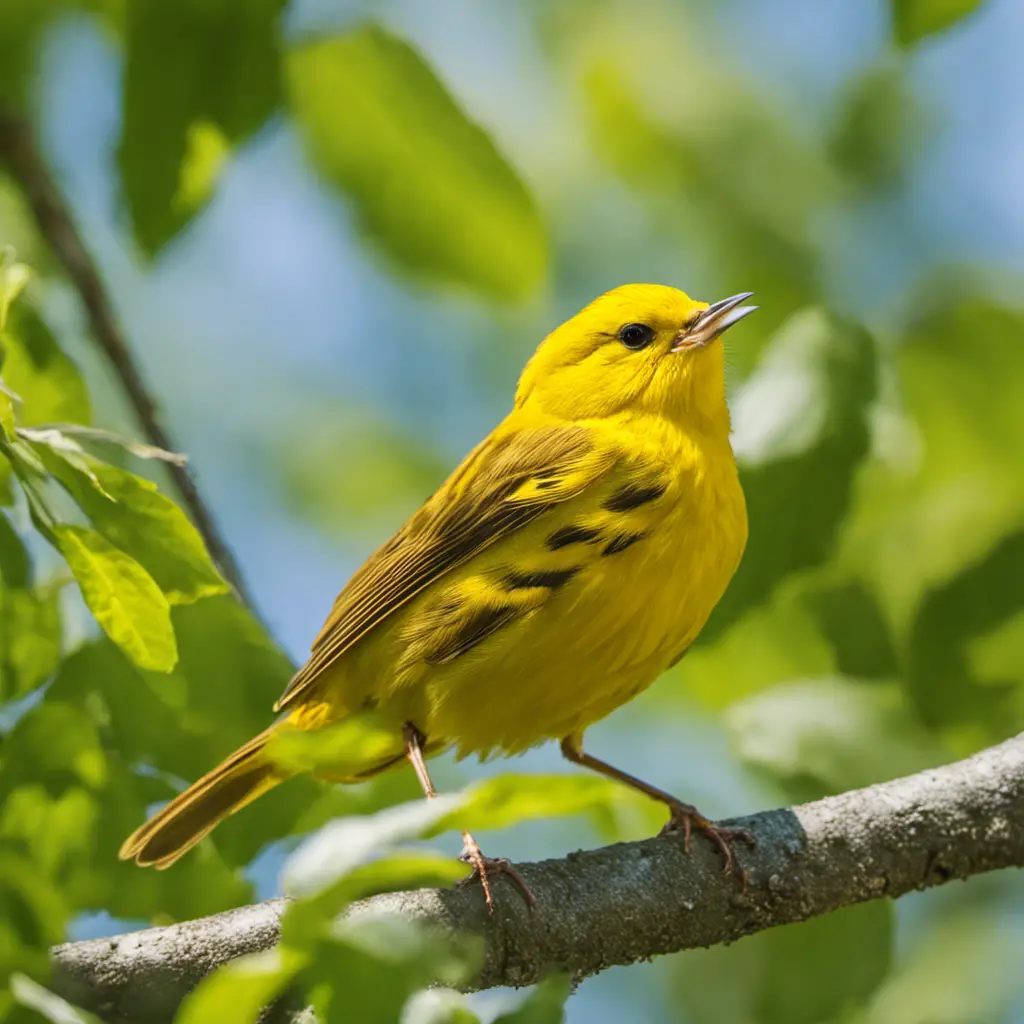
You should check out the three American Yellow Warblers that were spotted near the river today.
The American Yellow Warbler (Setophaga petechia) is a small, migratory bird that can be found across North America. These warblers are known for their vibrant yellow plumage, with males sporting streaks of reddish-brown on their chests. They’re highly active and agile birds, often seen flitting among the foliage in search of insects.
American Yellow Warblers are neotropical migrants, which means they breed in North America during the summer and then migrate to Central and South America for the winter. Their migration patterns are fascinating, as they undertake long-distance journeys, spanning thousands of miles. By studying these migration patterns, scientists gain valuable insights into the behavior and ecology of these beautiful birds.
Yellow Warbler

There are five Yellow Warblers spotted in the nearby forest this morning.
The Yellow Warbler (Setophaga petechia) is a small songbird that breeds across North America, including parts of Pennsylvania. These birds are known for their vibrant yellow plumage and melodic songs.
In terms of breeding habits, Yellow Warblers are monogamous and typically build cup-shaped nests in shrubs or trees, using materials such as grass and bark. They lay an average of four to five eggs per clutch and both parents take turns incubating them.
When it comes to migration patterns, Yellow Warblers are neotropical migrants, meaning they travel long distances to their wintering grounds in Central and South America.
These birds play an important role in maintaining ecological balance and are a delight to observe during their breeding season.
Black-throated Blue Warbler

You might spot a few Black-throated Blue Warblers in the forest during their migration this time of year. These small, migratory songbirds are known for their striking appearance, with males sporting a deep blue back and black throat, while females have a more muted, olive-brown coloration.
Here are some key points about the migration patterns and preferred habitats of Black-throated Blue Warblers:
Migration Patterns:
- Black-throated Blue Warblers breed in the northeastern United States and southeastern Canada.
- During the spring, they undertake a long-distance migration to their breeding grounds, which can extend as far as northern New England and Canada.
- In the fall, they migrate back to their wintering grounds in the Caribbean and Central America.
Preferred Habitats:
- Black-throated Blue Warblers are typically found in mature deciduous forests, especially those with a dense understory and a mix of trees.
- They prefer habitats with a dense vegetation structure, as it provides cover and nesting sites.
- These warblers also show a preference for areas with a high tree canopy cover, as it offers protection and shade.
Understanding the migration patterns and preferred habitats of Black-throated Blue Warblers is crucial for conservation efforts and ensuring their continued survival. By preserving suitable forest habitats and protecting their migratory routes, we can help these beautiful birds thrive for generations to come.
Black-throated Green Warbler

Spotting a Black-throated Green Warbler during its spring migration can be a thrilling experience, as these small songbirds bring vibrant flashes of yellow and green to the forest.
The Black-throated Green Warbler, scientifically known as Setophaga virens, is a migratory bird that breeds in the northern forests of North America and winters in Central America and the Caribbean. This warbler is known for its distinctive black throat and olive-green back.
During the breeding season, the female builds a cup-shaped nest made of bark, grasses, and moss, hidden among the branches of a coniferous tree.
The migration patterns of this species vary, with individuals traveling along the Atlantic coast or through the central United States. By studying their migration patterns, scientists can better understand the factors influencing their population dynamics and conservation needs.
Blackburnian Warbler
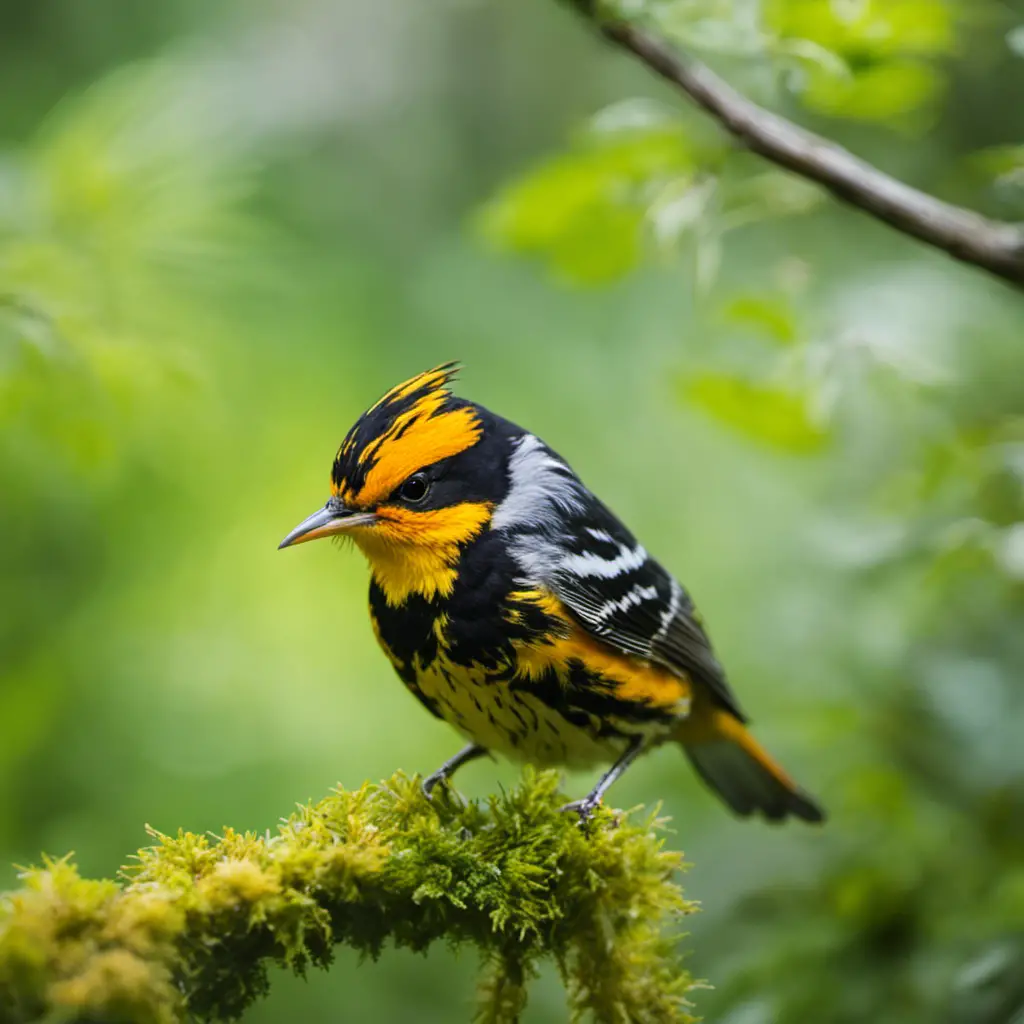
Have you ever seen a Blackburnian Warbler? They’re known for their vibrant orange throat and black and white plumage. These small songbirds, weighing only about 0.3 ounces, are fascinating creatures with unique migration patterns and breeding behavior.
Here are some key facts about Blackburnian Warblers:
Migration Patterns: Blackburnian Warblers are neotropical migrants, which means they spend their winters in Central and South America and migrate to North America for breeding season. They travel long distances, sometimes covering over 3,000 miles during their migration.
Breeding Behavior: During the breeding season, male Blackburnian Warblers establish territories and use their vibrant orange throat to attract females. They build cup-shaped nests in the upper branches of coniferous trees, using materials like twigs, moss, and lichen.
Song: Male Blackburnian Warblers have a distinctive high-pitched song that can be described as a high, thin, and buzzy ‘zee zee zee zee zee zee.’
Conservation Status: Blackburnian Warblers are currently listed as a species of least concern. However, their populations are declining due to habitat loss and deforestation in their wintering and breeding grounds.
Understanding the migration patterns and breeding behavior of Blackburnian Warblers is crucial for their conservation and ensuring their long-term survival. By studying and protecting their habitats, we can help these beautiful birds thrive.
Blackpoll Warbler

There are many different species of warblers in Pennsylvania, including the Blackpoll Warbler. The Blackpoll Warbler, scientifically known as Setophaga striata, is a small songbird that belongs to the family Parulidae. This species is known for its distinctive black cap and white underparts.
Blackpoll Warblers are found throughout North America during the breeding season, but they undertake one of the longest migrations of any songbird. In the fall, they fly nonstop for over 2,000 miles from their breeding grounds in northern Canada and Alaska to their wintering grounds in South America. This incredible journey takes them across the Atlantic Ocean and is facilitated by their ability to store large amounts of fat.
During the breeding season, Blackpoll Warblers build their nests in coniferous forests, usually high up in the trees. They typically lay 4-5 eggs and both parents take turns incubating them for about two weeks. Once the eggs hatch, both parents are responsible for feeding the chicks until they fledge.
The Blackpoll Warbler’s migration patterns and breeding habits are fascinating topics of study that help us better understand the behaviors and adaptations of these amazing birds.
Blue-winged Warbler
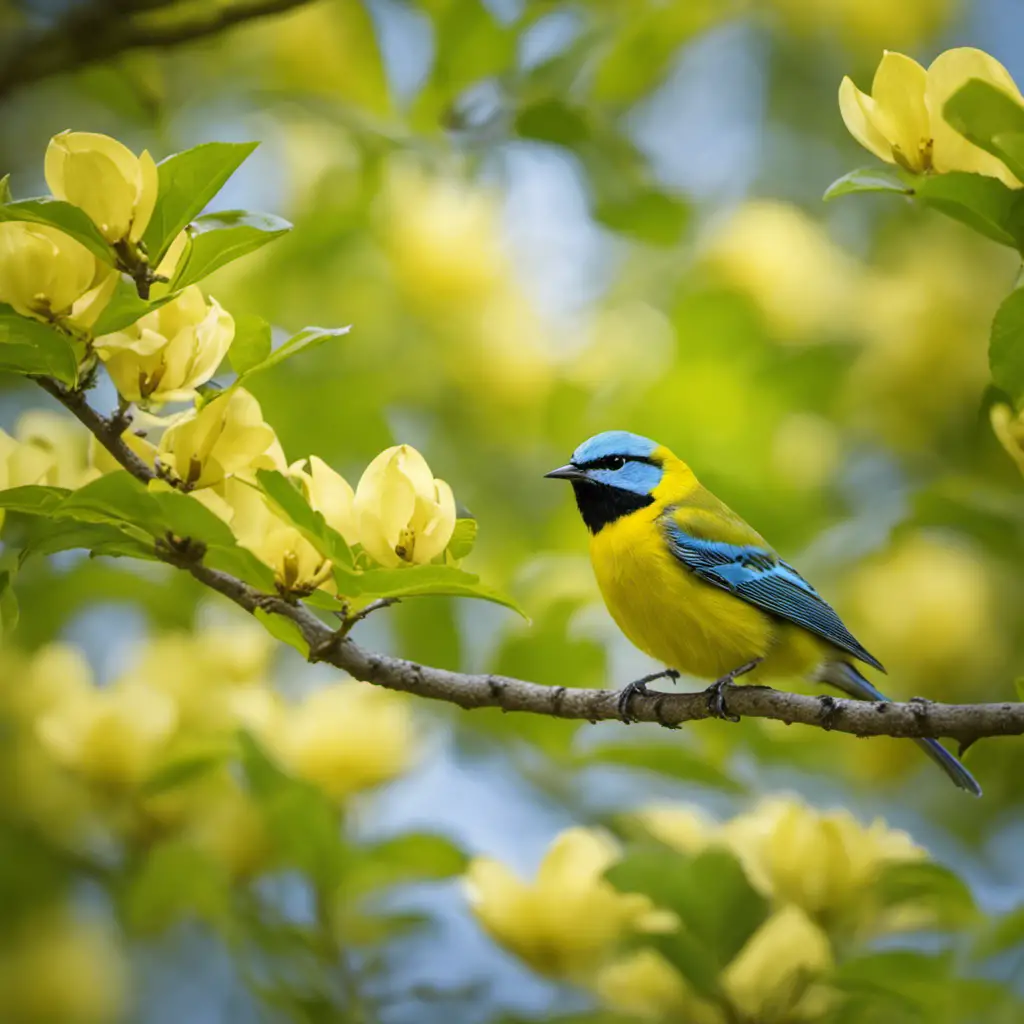
You occasionally see the Blue-winged Warbler during the spring migration in Pennsylvania. This small songbird is known for its striking blue wings and yellow underparts.
Here are some key facts about the Blue-winged Warbler:
Breeding habits: Blue-winged Warblers prefer open habitats such as shrubby fields and young forests for nesting. They build cup-shaped nests on the ground or in low shrubs, using materials like grasses and plant fibers.
Migration patterns: Blue-winged Warblers undertake long-distance migrations, spending their winters in Central and northern South America, and breeding in the eastern United States. They arrive in Pennsylvania in late April or early May, and can be spotted until September when they begin their southward journey.
Diet: These warblers primarily feed on insects, including caterpillars, beetles, and spiders. They also consume some fruits and nectar during migration.
Conservation status: The Blue-winged Warbler is currently listed as a species of least concern, but their populations have declined in some areas due to habitat loss and fragmentation.
Overall, the Blue-winged Warbler’s breeding habits and migration patterns make it a fascinating species to study, providing valuable insights into avian ecology and conservation.
Canada Warbler

You can spot the Canada Warbler by listening for its melodious singing during the breeding season. These small songbirds are known for their beautiful songs, which can be heard in the forests of Pennsylvania. The Canada Warbler is a migratory bird that travels long distances between its breeding grounds in Canada and its wintering grounds in South America. They follow a specific migration route, known as the Eastern Flyway, which takes them through Pennsylvania. However, these birds face numerous threats along their journey, including habitat loss and climate change. Conservation efforts are being made to protect the Canada Warbler and its habitat in Pennsylvania. These include creating protected areas, restoring forests, and raising awareness about the importance of preserving these birds and their ecosystems. By understanding the migration patterns of Canada Warblers and implementing conservation measures, we can ensure their survival for future generations.
| Migration Patterns of Canada Warblers | Conservation Efforts for Canada Warblers in Pennsylvania |
|---|---|
| – Breeding grounds in Canada | – Creating protected areas |
| – Wintering grounds in South America | – Restoring forests |
| – Follow the Eastern Flyway | – Raising awareness about conservation |
| – Face threats such as habitat loss | – Preserving ecosystems |
Cape May Warbler
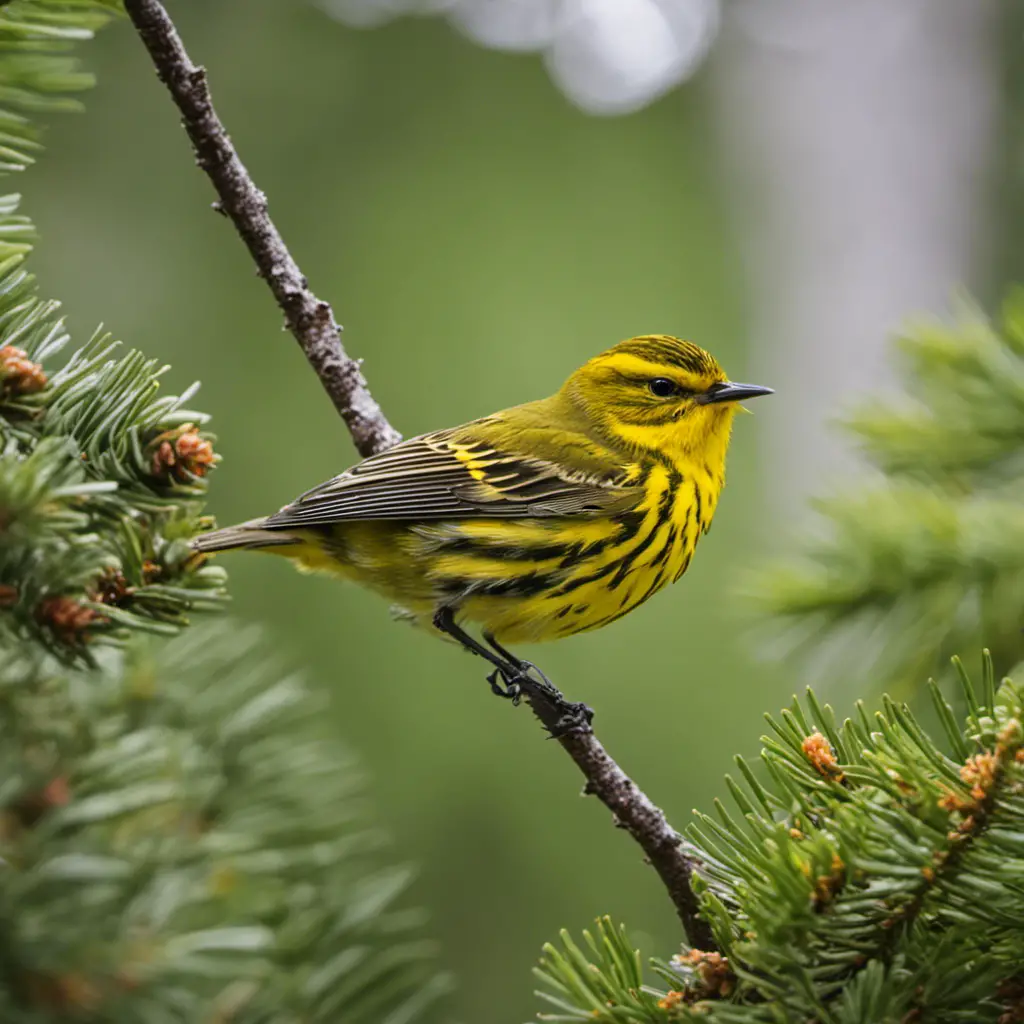
If you look closely in the forests of Pennsylvania, you might spot a Cape May Warbler, as they’re known to pass through this area during their migratory journey. These small, vibrant birds undertake an impressive migration each year, traveling from their wintering grounds in the Caribbean to their breeding grounds in the boreal forests of Canada.
Here are four key points to understand about the Cape May Warbler’s migration patterns:
Timing: Cape May Warblers typically begin their northward migration in late April or early May, reaching their breeding grounds by late May or early June.
Route: These warblers follow a route known as the ‘Atlantic Flyway,’ which takes them along the eastern coast of North America, including Pennsylvania.
Stopovers: During their journey, Cape May Warblers rely on stopover sites to rest and refuel. These sites, often located in coastal areas, provide the necessary resources for their long-distance flight.
Conservation Efforts: Due to habitat loss and climate change, Cape May Warbler populations are declining. Conservation efforts focus on protecting their breeding grounds, ensuring stopover sites are preserved, and raising awareness about the importance of these birds.
Cerulean Warbler
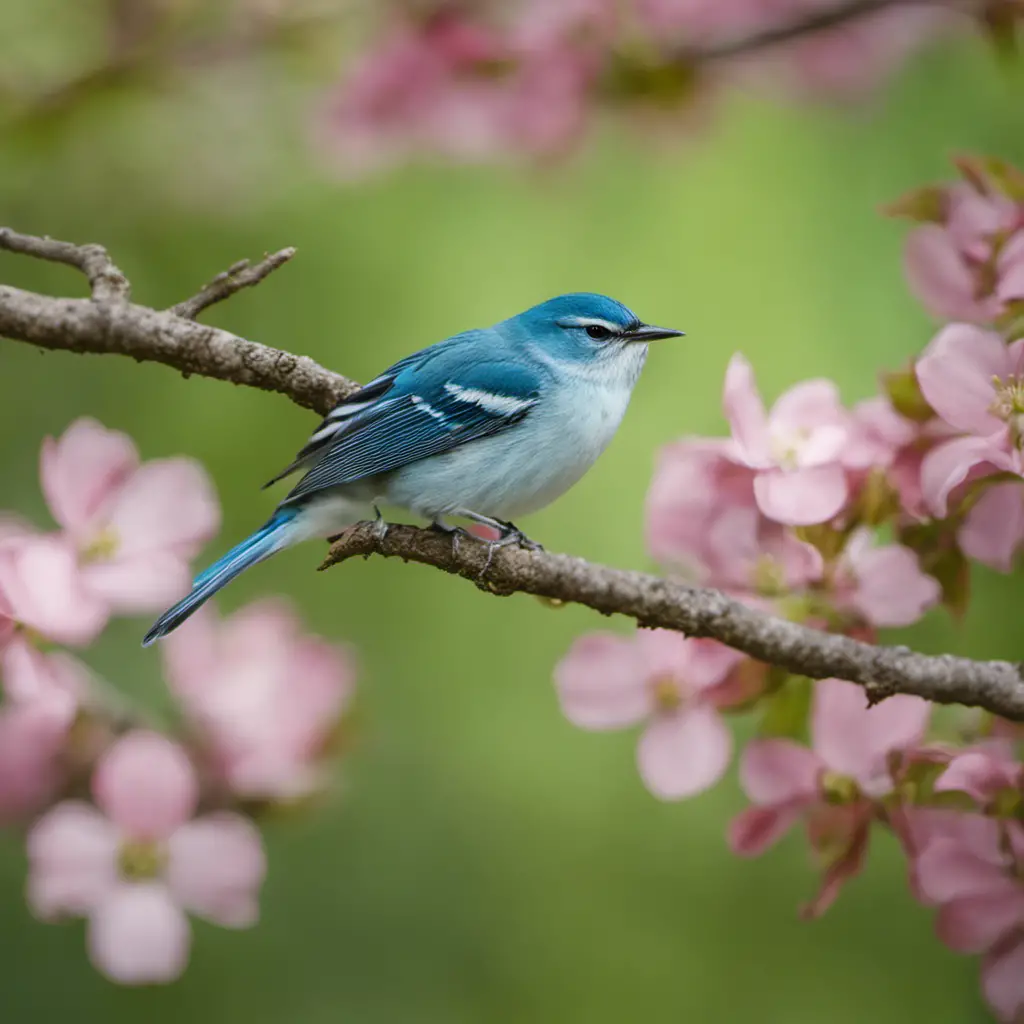
Spotting a few Cerulean Warblers in the forests of Pennsylvania is a rare and exciting experience. These small, migratory songbirds are known for their vibrant blue plumage and melodic songs. However, their population has been declining due to habitat loss and fragmentation. As a result, conservation efforts have been initiated to protect their breeding and wintering grounds.
These efforts include creating and maintaining suitable habitats, such as mature forests with a dense canopy cover. Additionally, researchers have been studying Cerulean Warbler migration patterns to better understand their movements and identify critical stopover sites. By tracking their routes and stopover locations, conservationists can target their efforts to protect these areas and ensure the survival of the Cerulean Warbler population.
It’s crucial that we continue to support these conservation initiatives to preserve this beautiful species for future generations.
Chestnut-sided Warbler

When you spot a Chestnut-sided Warbler in Pennsylvania, it’s important to observe its unique plumage and listen to its distinctive song. Here are some key points to understand about the behavioral patterns and breeding habitats of this fascinating bird:
Behavior:
- The Chestnut-sided Warbler is known for its energetic foraging behavior, often seen flitting through the treetops in search of insects.
- It has a tendency to hover momentarily before darting towards its prey.
- This warbler also exhibits territorial behavior during the breeding season, defending its nesting area against intruders.
Plumage:
- The male Chestnut-sided Warbler sports a bold plumage with chestnut-colored flanks, a yellow forehead, and a white belly.
- The female, on the other hand, has a more subdued appearance with olive-green upperparts and a yellowish belly.
Song:
- The Chestnut-sided Warbler’s song is a melodic series of high-pitched notes, often described as ‘pleased-pleased-pleased to meetcha.’
- It’s known for its distinct and easily recognizable call, which helps birdwatchers identify this species.
Breeding Habitats:
- This warbler prefers breeding habitats with a mix of deciduous and coniferous trees, such as young forests, woodland edges, and second-growth areas.
- It typically constructs its nest in shrubs or low branches, using grass, bark, and other plant materials.
Understanding the behavioral patterns and breeding habitats of the Chestnut-sided Warbler is essential for bird enthusiasts and researchers alike. By studying and conserving these habitats, we can contribute to the preservation of this beautiful species.
Golden-winged Warbler

Have you heard the melodic song of the Golden-winged Warbler, and do you know how to identify its distinct golden wing patches?
The Golden-winged Warbler (Vermivora chrysoptera) is a small migratory bird that can be found in North America. This species is known for its striking appearance, with bright yellow plumage and, as the name suggests, golden wing patches.
One of the main topics of discussion surrounding the Golden-winged Warbler is conservation efforts. Due to habitat loss and fragmentation, the population of this species has been declining rapidly. Conservationists are working to protect and restore the habitats that are essential for the survival of these birds.
Another important aspect of the discussion revolves around the Golden-winged Warbler’s habitat preferences. This species prefers early successional habitats, such as shrubby areas and young forests. Understanding these preferences is crucial for implementing effective conservation strategies to ensure the survival of the Golden-winged Warbler.
Hooded Warbler

You can easily identify the Hooded Warbler by its distinct black hood and bright yellow plumage. This small songbird is commonly found in the eastern United States, including Pennsylvania.
Here are some key points to understand about the Hooded Warbler’s habitat preferences and breeding behavior:
Habitat preferences:
- The Hooded Warbler prefers dense understory habitats, such as deciduous forests and shrubby areas near water sources.
- They’re often found in lowland areas, but can also be found in higher elevations during migration.
- They tend to avoid open fields and heavily disturbed areas.
Breeding behavior:
- Male Hooded Warblers are known for their elaborate courtship displays, which include singing and fluttering their wings.
- They’re monogamous and form pairs during the breeding season.
- They build cup-shaped nests on or close to the ground, usually hidden in thick vegetation.
- The female lays 3-5 eggs and both parents take turns incubating them.
Understanding the Hooded Warbler’s habitat preferences and breeding behavior is crucial for conservation efforts and ensuring their survival in Pennsylvania.
Kentucky Warbler
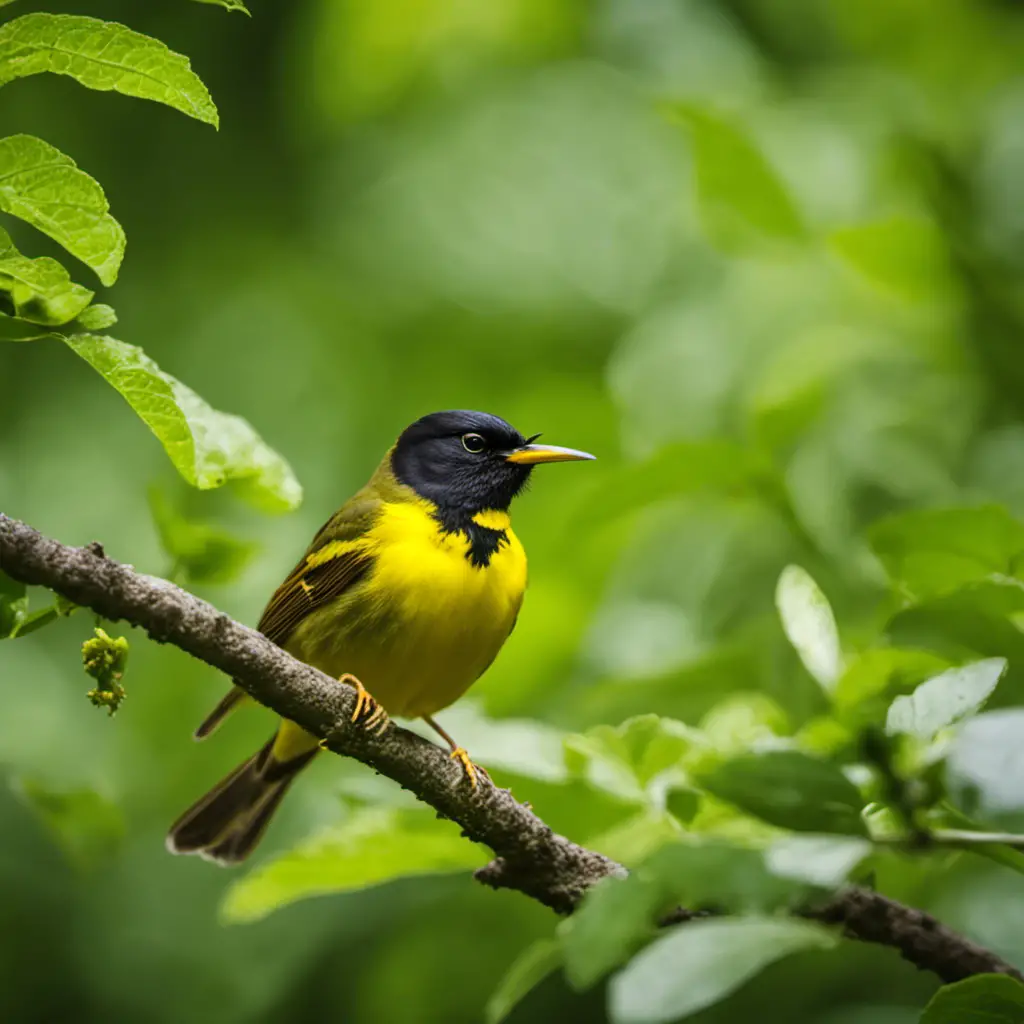
If you want to spot a Kentucky Warbler in Pennsylvania, look for dense understory habitats near water sources. These small migratory birds are known for their vibrant yellow plumage and distinct black mask. The Kentucky Warbler is a neotropical migrant, meaning it travels long distances between its breeding grounds in the eastern United States and its wintering grounds in Central and South America. During migration, these birds rely on specific habitats that provide the necessary resources for their survival. According to research, Kentucky Warblers have a strong preference for dense understory vegetation, particularly near water sources such as streams or wetlands. They require this dense habitat for nesting and foraging, as it provides cover and access to their preferred food sources, which include insects, spiders, and small fruits.
To further emphasize the habitat preferences of the Kentucky Warbler, the following table highlights the key factors that contribute to their habitat selection:
| Habitat Preference | Key Factors |
|---|---|
| Vegetation Structure | Dense understory vegetation |
| Water Sources | Proximity to streams, wetlands, or other water sources |
| Nesting Requirements | Availability of suitable nesting sites, such as shrubs or low vegetation |
| Food Availability | Abundance of insects, spiders, and small fruits |
| Connectivity | Presence of nearby forested areas and suitable habitats for migration, as well as access to water and food resources during transit |
Magnolia Warbler

During the spring migration season, make sure to keep an eye out for the Magnolia Warbler as it passes through Pennsylvania. This small, brightly colored songbird is known for its distinctive black mask and yellow underparts, making it easy to spot among the trees.
Here are four key points to help you understand the migration patterns and breeding behavior of the Magnolia Warbler:
Migration Patterns: The Magnolia Warbler is a long-distance migrant, traveling from its wintering grounds in Central America and the Caribbean to its breeding grounds in the boreal forests of Canada and the northeastern United States, including Pennsylvania.
Breeding Behavior: Once the Magnolia Warblers arrive at their breeding grounds, they engage in courtship displays, with males singing to attract females. They build cup-shaped nests in the understory of deciduous or mixed forests, using materials such as grass, bark, and moss.
Nesting Habits: The female Magnolia Warbler lays around 4-5 eggs, which she incubates for about 12-13 days. Both parents take turns feeding the chicks, primarily with insects.
Post-breeding Migration: After the breeding season, the Magnolia Warblers embark on their southward migration, following a similar route as their spring migration.
Mourning Warbler

When the Mourning Warbler arrives in Pennsylvania, it can be easily identified by its distinct black mask and grayish-brown plumage. This small songbird, measuring around 5-6 inches in length, is a neotropical migrant that breeds in the boreal forests of North America. Its preferred habitat includes dense shrubs and understory vegetation near wetlands and streams. The Mourning Warbler is known for its unique migration pattern. It spends the winter months in Central and South America, and then migrates northward to breed during the summer. This species is considered a long-distance migrant, traveling thousands of miles each year. To better understand the Mourning Warbler’s migration patterns, let’s take a look at the table below:
| Migration Period | Location |
|---|---|
| Winter | Central/South America |
| Spring | Eastern United States |
| Summer | Boreal forests of North America |
Nashville Warbler
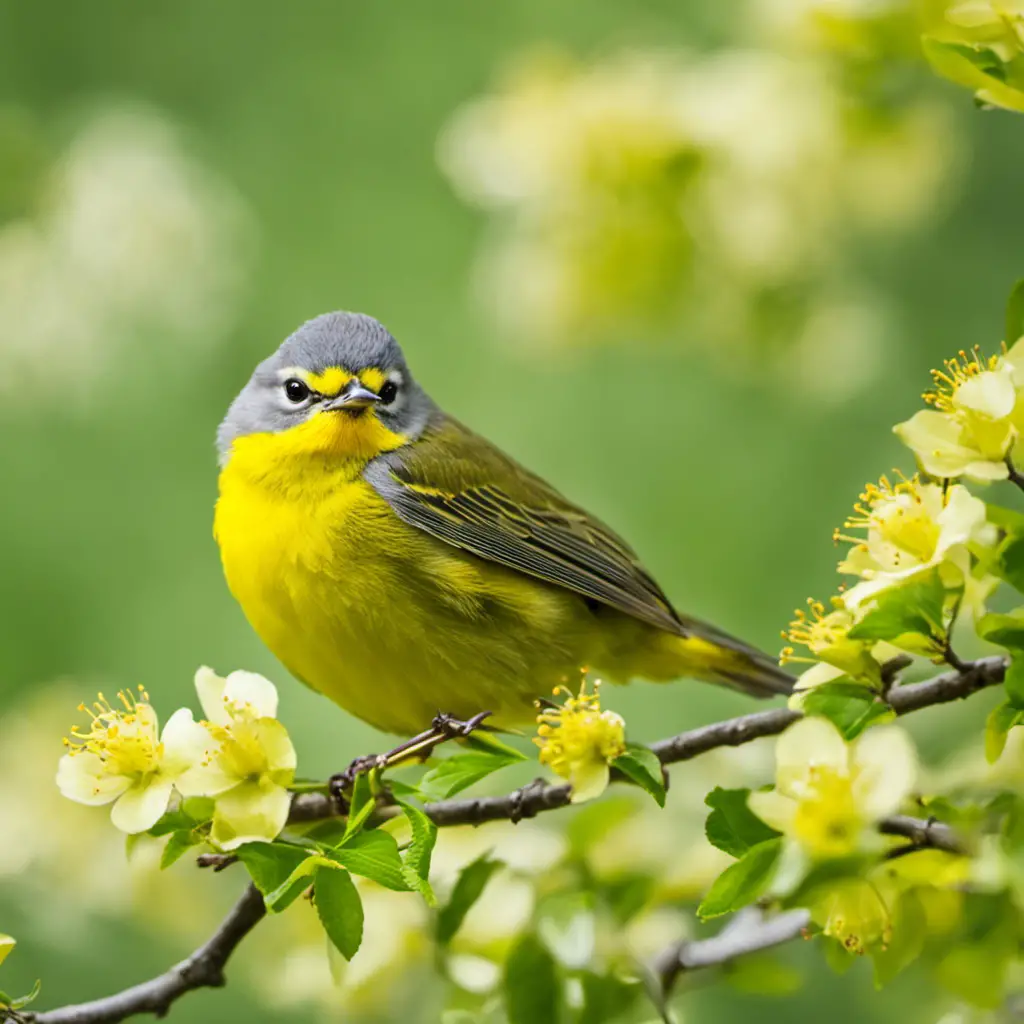
You can easily spot the Nashville Warbler in Pennsylvania during the spring migration, as it passes through the state on its way to its breeding grounds. Here are some key points about the Nashville Warbler’s migration patterns and habitat preferences:
Migration patterns: The Nashville Warbler is a neotropical migrant, which means it breeds in North America and spends the winter in Central and South America. It’s one of the earliest warblers to arrive in Pennsylvania during the spring migration, usually around mid-April. It then continues its journey to its breeding grounds in the boreal forests of Canada.
Habitat preferences: During migration, the Nashville Warbler can be found in a variety of habitats, including woodlands, shrubby areas, and gardens. It prefers areas with dense vegetation and a mix of tree species, as it feeds on insects and spiders found in the foliage.
Breeding grounds: Once the Nashville Warbler reaches its breeding grounds in Canada, it prefers to nest in coniferous forests, particularly those with a dense understory. It constructs its cup-shaped nest on or near the ground, usually hidden among vegetation or fallen logs.
Conservation status: The Nashville Warbler is considered a species of least concern, with stable populations throughout its range. However, like many other migratory birds, it faces threats from habitat loss and climate change. Efforts to protect and conserve its breeding, wintering, and stopover habitats are crucial for its long-term survival.
Palm Warbler
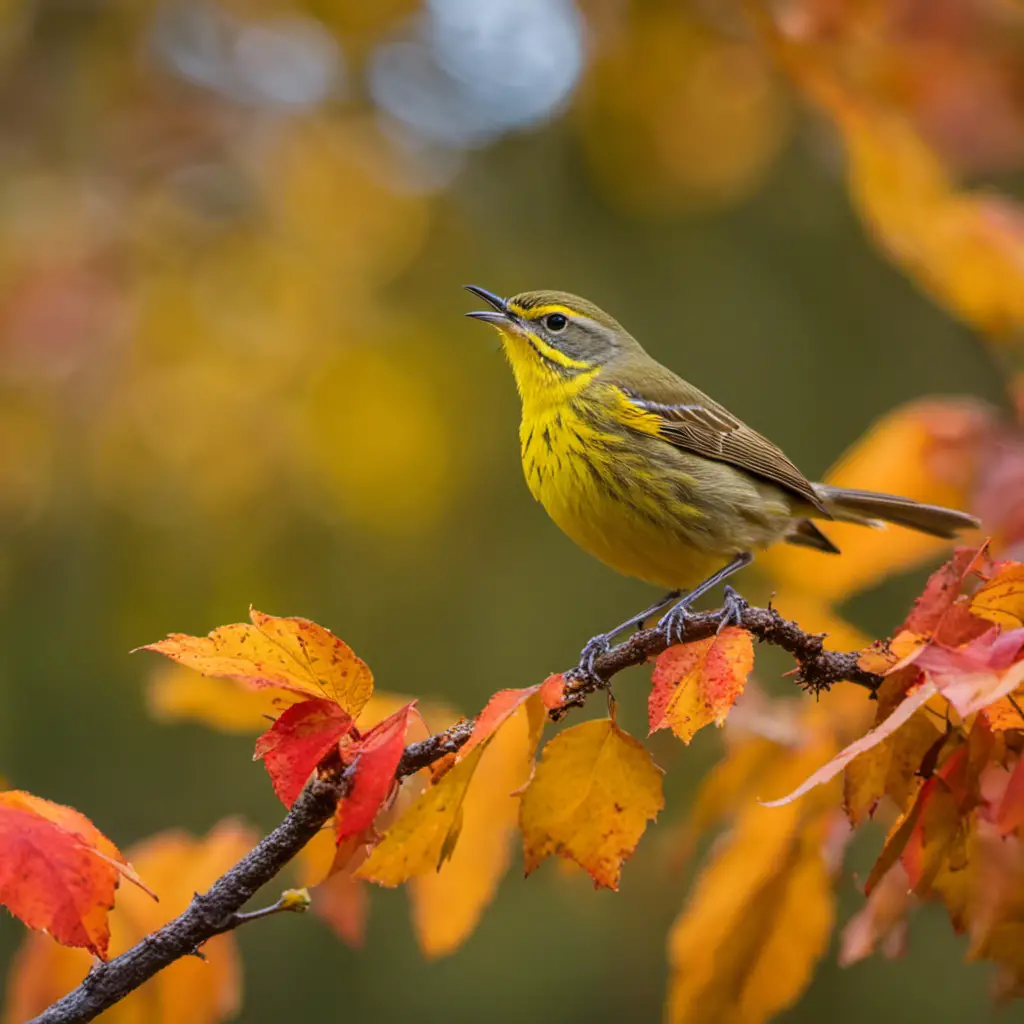
Spotting a Palm Warbler in Pennsylvania can be an exciting experience, as they are known for their distinctive tail-wagging behavior. These small songbirds are a common sight during their migration periods, as they travel from their breeding grounds in the boreal forests of Canada to their wintering grounds in the southeastern United States and the Caribbean. Palm Warblers prefer habitats with dense understory vegetation, such as shrubby fields, bogs, and marshes. They are often seen foraging on the ground, flicking their tails up and down as they search for insects and seeds. The following table provides a summary of Palm Warbler migration patterns and habitat preferences:
| Migration Patterns | Habitat Preferences |
|---|---|
| Spring/Fall | Boreal Forests |
| Winter | Southeastern US |
| Breeding | Canada |
| Foraging | Shrubby Fields |
Understanding the Palm Warbler’s migration patterns and habitat preferences can help birdwatchers and conservationists better appreciate and protect these fascinating birds.
Pine Warbler
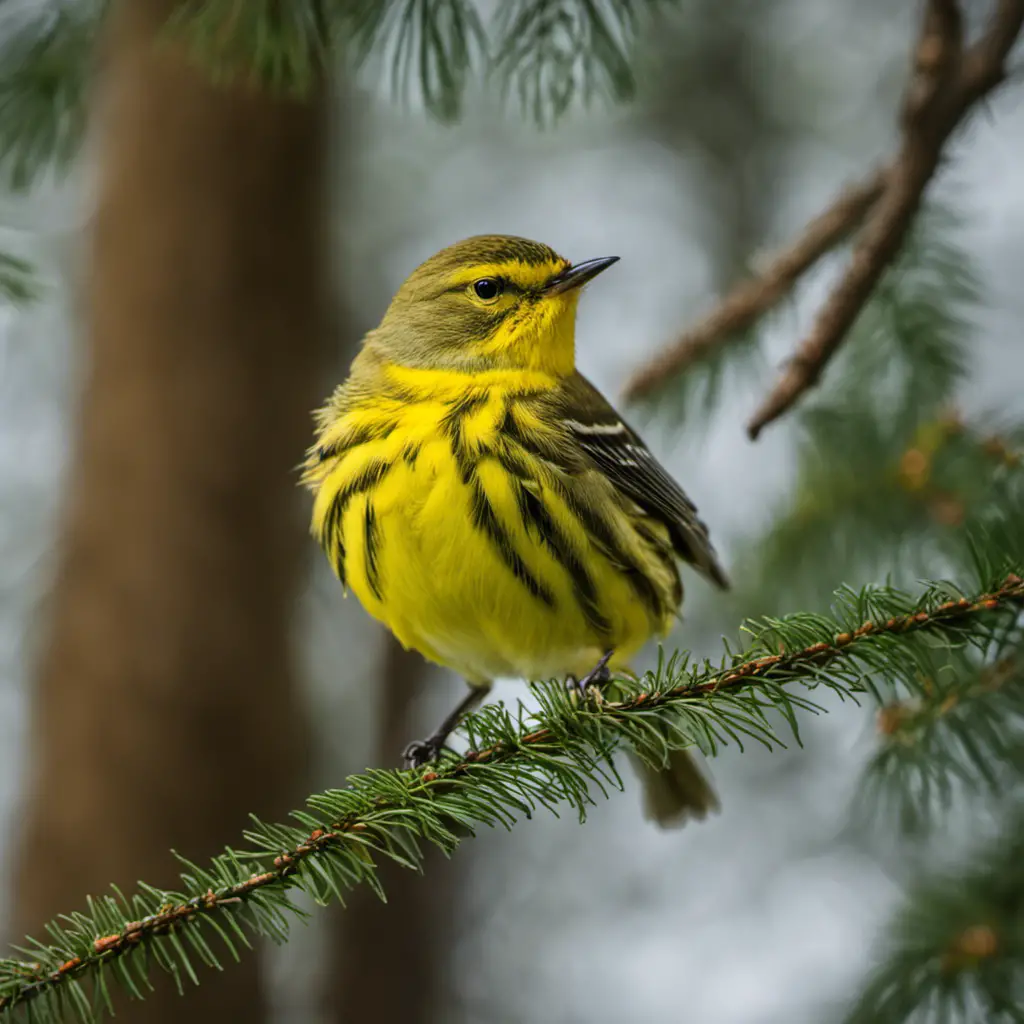
If you’re looking for a vibrant yellow warbler, the Pine Warbler is a great option to consider. This species is known for its beautiful plumage and melodious song.
Here are some key facts about the Pine Warbler’s habitat preferences and migration patterns:
Habitat preferences:
- The Pine Warbler is primarily found in pine forests, hence its name.
- It prefers mature pine stands with open understory and sandy soil.
- These warblers can also be found in mixed forests where pines are present.
- They’re more common in the southern parts of their range, but can be found breeding as far north as Canada.
Migration patterns:
- Pine Warblers are considered short-distance migrants.
- During the breeding season, they can be found in the eastern United States and southern Canada.
- In winter, they migrate to the southeastern United States and Mexico.
- Some individuals may also overwinter in coastal regions of the northeast.
Understanding the habitat preferences and migration patterns of the Pine Warbler is crucial for conserving this species and ensuring its survival. By protecting suitable pine forest habitats and maintaining diverse landscapes, we can continue to enjoy the presence of these vibrant yellow warblers in our surroundings.
Prairie Warbler
There are several warbler species that can be found in Pennsylvania, and one of them is the Prairie Warbler. The Prairie Warbler (Setophaga discolor) is a small, vibrantly colored songbird that is known for its distinctive yellow plumage with black streaks on its sides. It is primarily found in shrubby habitats such as fields, meadows, and open woodlands. The species is known to breed in the eastern United States, including Pennsylvania, during the summer months. However, during the winter, Prairie Warblers migrate to the southern United States, Mexico, and the Caribbean islands. This species exhibits a unique migration pattern, with some individuals migrating as far as South America. The Prairie Warbler’s migration patterns are influenced by factors such as food availability and weather conditions. Overall, understanding the Prairie Warbler’s habitat and migration patterns is crucial for its conservation and management.
| Prairie Warbler Habitat | Prairie Warbler Migration Patterns |
|---|---|
| Shrubby habitats | Breeds in eastern US |
| Fields, meadows, woodlands | Migrates to southern US, Mexico, Caribbean |
| Some individuals migrate to South America |
Prothonotary Warbler
You can easily identify the Prothonotary Warbler by its bright yellow plumage and the unique way it builds its nest in tree cavities. Here are some interesting facts about this species:
Habitat Preferences: The Prothonotary Warbler is primarily found in wetland areas such as swamps, marshes, and river floodplains. They’ve a strong affinity for habitats with standing water and dense vegetation, particularly near the edges of wooded areas.
Nesting Behavior: Unlike many other warbler species, Prothonotary Warblers build their nests in tree cavities instead of constructing a cup-shaped nest. They often select cavities in dead or decaying trees, using moss, leaves, and other plant materials to line the nest.
Population Trends: The population of Prothonotary Warblers has been declining in recent years due to habitat loss and degradation. The destruction of wetland habitats and the conversion of forests into agricultural land have greatly impacted their breeding success and overall population numbers.
Conservation Efforts: To conserve the Prothonotary Warbler, efforts are being made to protect and restore wetland habitats, as well as create artificial nest boxes to provide additional nesting opportunities. Monitoring programs are also in place to track population trends and assess the effectiveness of conservation measures.
Understanding the habitat preferences and population trends of the Prothonotary Warbler is crucial for implementing effective conservation strategies and ensuring the long-term survival of this beautiful species.
Tennessee Warbler
The Tennessee Warbler is known for its olive-green plumage and its habit of foraging in the upper parts of trees. This small migratory songbird, scientifically known as Vermivora peregrina, is a common sight during its breeding season in the boreal forests of Canada and the northern United States. However, during the fall migration, these warblers can be spotted in various parts of the eastern and central regions of North America, including Pennsylvania. The Tennessee Warbler prefers to inhabit coniferous and mixed forests, where it can find ample food sources such as insects and spiders. Its migration patterns are unique, as it travels long distances from its breeding grounds to its wintering grounds in Central and South America. The table below provides a summary of the Tennessee Warbler’s migration patterns and habitat preferences.
| Migration Patterns | Habitat Preferences |
|---|---|
| Long-distance | Coniferous forests |
| Mixed forests | |
| Central and South America |
Understanding the Tennessee Warbler’s migration patterns and habitat preferences is crucial for conservation efforts and ensuring the species’ survival. By protecting its breeding and wintering grounds, we can help maintain healthy populations of these beautiful migratory birds.
Wilson’s Warbler
Sometimes, you may spot Wilson’s Warblers flitting about in the undergrowth, foraging for insects and spiders. These small, vibrant yellow birds are known for their distinctive black caps and bold black eyes.
Here are some discussion ideas about the habitat preferences and migration patterns of the Wilson’s Warbler:
Habitat Preferences: Wilson’s Warblers prefer dense, shrubby habitats such as wetlands, thickets, and forest edges. They’re often found near water sources like streams and marshes. These areas provide the necessary cover and food sources for the warblers.
Migration Patterns: Wilson’s Warblers are neotropical migrants, spending their breeding season in North America and migrating to Central and South America for the winter. They undertake long-distance migrations, flying thousands of miles each way.
When it comes to conservation efforts and threats facing the Wilson’s Warbler population in Pennsylvania, the following points should be considered:
Conservation Efforts: Conservation organizations and bird enthusiasts are working to protect and restore suitable habitats for Wilson’s Warblers. These efforts include creating and maintaining shrubby areas, preserving wetlands, and promoting sustainable land management practices.
Threats: The Wilson’s Warbler population in Pennsylvania faces several threats, including habitat loss due to urbanization and agriculture, pesticide use, and climate change. These factors can disrupt their breeding and migration patterns and reduce their available food sources.
Understanding the habitat preferences and migration patterns of Wilson’s Warblers, as well as the conservation efforts and threats they face, is crucial for ensuring the long-term survival of this beautiful species in Pennsylvania.
Worm-eating Warbler
If you look closely in the dense undergrowth, you might spot a Worm-eating Warbler flitting about, searching for insects to eat. These small, migratory birds are known for their distinctive behavior and habitat preferences. The Worm-eating Warbler prefers to make its home in deciduous forests with dense understory vegetation, particularly in the eastern United States. They can be found in Pennsylvania during the breeding season, where they build cup-shaped nests on the ground or low in shrubs. As their name suggests, their primary diet consists of insects, especially caterpillars and spiders. They forage by hopping along the forest floor or climbing tree trunks, using their slender beaks to probe for prey in bark crevices and leaf litter. This feeding behavior allows them to obtain the necessary nutrients for survival and reproduction. The Worm-eating Warbler’s habitat preferences and feeding behavior are crucial for their survival and contribute to the delicate balance of ecosystems they inhabit.
| Worm-eating Warbler | |
|---|---|
| Habitat Preferences | Deciduous forests with dense understory vegetation |
| Feeding Behavior | Foraging on the forest floor and climbing tree trunks to find insects, especially caterpillars and spiders |
Yellow-rumped Warbler
You might be interested to know that the Yellow-rumped Warbler’s distinctive yellow patches on its rump and sides make it easy to identify in the field. This species is a common migrant and breeder in Pennsylvania, and understanding its migration patterns and breeding habits is crucial for bird enthusiasts.
Here are some key points to consider:
Migration patterns:
- Yellow-rumped Warblers undertake long-distance migrations, traveling from their breeding grounds in North America to wintering areas in Central and South America.
- They follow specific flyways, such as the Atlantic and Mississippi Flyways, during their migration.
- These warblers typically arrive in Pennsylvania during spring migration, with peak numbers observed in late April and early May.
- In the fall, they migrate southward, often in mixed flocks with other species.
Breeding habits:
- Yellow-rumped Warblers breed in coniferous and mixed forests, as well as in shrubby habitats.
- They construct cup-shaped nests made of twigs, grasses, and bark, typically placed in trees or shrubs.
- Males attract mates by singing complex, high-pitched songs, and both parents participate in raising the young.
- Their breeding range extends from Alaska and Canada to northern parts of the United States.
Understanding the migration patterns and breeding habits of the Yellow-rumped Warbler contributes to our overall knowledge of bird behavior and ecology. By studying these aspects, we can better appreciate and conserve this beautiful species and its habitats.
Yellow-throated Warbler
You can easily distinguish the Yellow-throated Warbler from other warbler species by its vibrant yellow throat and distinctive black eye stripe. This small songbird is known for its striking appearance and unique behaviors.
The Yellow-throated Warbler is primarily found in the southeastern United States, but it also migrates to parts of Mexico and the Caribbean during the winter months. Its migration patterns aren’t well understood, but it’s believed to follow similar routes as other warbler species.
During the breeding season, this warbler prefers to inhabit mature forests with a dense canopy and a mix of hardwood and pine trees. It constructs its nest in the fork of a tree branch and lays a clutch of four to six eggs. Both males and females take part in incubating the eggs and caring for the young.
Overall, the Yellow-throated Warbler is a fascinating species with unique migration patterns and breeding habits.
Frequently Asked Questions
What Are the Distinguishing Features of the American Yellow Warbler?
The distinguishing features of the American yellow warbler include its bright yellow plumage, black streaks on its breast, and a yellow crown. They are commonly found in shrubby habitats across North America.
How Does the Yellow Warbler’s Habitat Differ From Other Warbler Species?
The yellow warbler’s habitat differs from other warbler species due to its specific preferences for dense shrubs and trees near wetlands. This creates a unique environment in Pennsylvania, attracting a diverse range of warbler species during migration.
What Is the Unique Behavior or Song of the Blackburnian Warbler?
The unique behavior of the Blackburnian warbler is its tendency to forage in the upper canopy of trees. Its song is a high-pitched, buzzy trill that helps establish territory and attract mates.
How Can One Differentiate Between the Palm Warbler and the Pine Warbler?
To differentiate between the palm warbler and the pine warbler, observe their distinguishing features. Look for the palm warbler’s yellow underparts, contrasting with its brown back, and the pine warbler’s overall yellow coloration. These similar species can be identified with careful observation.
What Is the Migratory Pattern of the Cape May Warbler and Where Does It Spend Its Winters?
The migratory pattern of the Cape May warbler involves traveling to the Caribbean and Central America during the winter months. These birds spend their winters in areas with suitable food sources and warmer climates.
Are Falcons and Warblers Native to Pennsylvania?
Falcons spotted in pennsylvania are mesmerizing bird species that have made their home in this state. These majestic creatures, known for their hunting skills and swift flight, add beauty and excitement to Pennsylvania’s natural landscape. Alongside falcons, warblers, another native bird species, also inhabit this region, filling the air with their delightful melodies. The presence of falcons and warblers showcases the diverse and thriving avian population in Pennsylvania.
Conclusion
In conclusion, Pennsylvania is home to a diverse range of warbler species. The American Yellow Warbler, Yellow Warbler, Black-throated Blue Warbler, Black-throated Green Warbler, Blackburnian Warbler, Wilson’s Warbler, Worm-eating Warbler, Yellow-rumped Warbler, and Yellow-throated Warbler can all be found in this state.
These warblers contribute to the ecological balance and biodiversity of Pennsylvania’s forests and wetlands.
Further research and conservation efforts are necessary to ensure the survival and well-being of these beautiful and important birds.

An avid ornithologist, zoologist and biologist with an unwavering passion for birds and wild animals.
Dr. Wilson’s journey in ornithology began in childhood and led him to obtain a Ph.D. in Ornithology from the prestigious Avian Research Institute. He has worked closely with renowned experts in the field and conducted extensive research and field studies globally.
